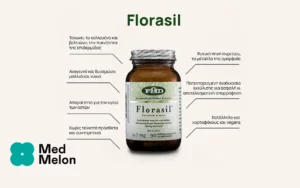Scientific Names of African Malva:
Malva sylvestris L. or M. sylvestris subsp. mauritiana (L.) ASCH. et GRAEBN. [Fam. Malvaceae]
Forms:
African mallow blossom tea; African mallow blossom cold liquid extracts
Traditional Usage:
– Anti-inflammatory
– Antioxidant
– Breathing Disorders
– Bronchitis
– Catarrh (respiratory mucous)
– Colds and flu
– Cough
– Digestive Upsets
– Gastritis
– Gastroenteritis
– Laryngitis
– Poultice
– Skin Problems
– Sore Throat
– Urinary Tract Problems
– Wounds
Overview:
The blossoms of African mallow, Malva sylvestris L. or M. sylvestris subsp. mauritiana (L.) ASCH. et GRAEBN. [Fam. Malvaceae] are rich in mucilage, a complex mixture of polysaccharides that form a soothing gelatinous fiber when water is added. The blossom tea was traditionally used internally for soothing sore throats, laryngitis and tonsillitis, coughs, dryness of the lungs and digestive upsets. Studies on irritated mucus membranes have shown that the mucilage of Malva sylvestris binds to buccal membranes and other mucous membranes of the body. Mucilage, as a good source of soluble fibre, is particularly recommended for soothing gastric diseases. The viscous fiber has several beneficial effects on digestion: 1) it reduces bowel transit time; 2) it absorbs toxins from the bowel; 3) it increases fecal bulk and dilutes stool materials thereby reducing stool contact with the intestinal mucosa; and 4) it enhances beneficial bacteria in the gut and provides an excellent substrate for bacterial fermentation. Mucilage helps to eliminate anaerobic pathogens from the gut, a function that can significantly help the body to normalize critical hormone balances needed for basic health. The blossom’s liquid extract also has noted anti-inflammatory activity and contains high concentrations of colorful purple flavonoids called anthocyanins. Anthocyanins are beneficial for skin health and are also known to coat the surface of cell membranes and protect them from enzymatic and free radical damage. Mallow blossoms are also used to alleviate urinary tract problems, which may be attributed to the action of anthocyanins and proanthocyanidins that prevent bacteria from adhering to the bladder wall. African mallow is also used as a poultice for healing wounds and skin inflammations. The powdered flowers and leaves of a related Malva species have been shown to stimulate cellular regeneration, cleansing and detoxification; researchers recommend the herb for both healthy and sick individuals.
Active Ingredients:
The leaves and blossoms of African Malva contain mucilage made up of high molecular weight acidic polysaccharides (HMWAPs), in the range of 1.3 to 1.6 x 10(6) D. The HMWAPs are composed mainly of glucuronic acid, galacturonic acid, rhamnose and galactose. The blossoms contain more than ten percent mucilage and make a pleasantly sweet tea, which on hydrolysis affords traces of galactose, arabinose, glucose, rhamnose and galacturonic acid. The polysaccharides include pentoses, methyl-pentoses and hexoses that form a soothing gelatinous fiber or mucilage. The blossoms also contain high concentrations of anti-oxidants including flavonoids and small amounts of tannin. Less than 0.1% leucoanthocyanins, but ca. 7% (based on dry wt.) anthocyanins, about half of which is malvidin 3,5-diglucoside (malvin); delphinidin and malvidin 3-glucosides are also present. For the rest, only ubiquitous substances have been detected.
Suggested Amount:
Unless otherwise prescribed, 1.5-2 grams of the finely chopped African Mallow Blossom is placed in cold water and boiled for a short time, or boiling water is poured over it, and after ten minutes strained. One Teaspoon = ca. 0.5 grams. African Mallow Blossom tea is taken 3-5 times per day, or as required.
Drug Interactions:
As with other concentrated sources of soluble fibre, African Mallow Blossom mucilage can interfere with the absorption of other medicines within the gut if they are taken at the same time. As such, take prescription medications at an alternate time to consuming African Mallow Blossom tea.
Contraindications:
None known
Side Effects:
None known
References:
Classen B, Blaschek W. 1998. High molecular weight acidic polysaccharides from Malva sylvestris and Alcea rosea. Planta Med 1998 Oct; 64(7): 640-4.
Duke, J. 1997: The Green Pharmacy, The Ultimate Compendium of Natural Remedies from the World’s Foremost Authority on Healing and Herbs. pp. 104; 119; 181; 187; 169-170; 372; 479; 491. Rodale Press.
Farina A, Doldo A, Cotichini V, Rajevic M, Quaglia MG, Mulinacci N, Vincieri FF. 1995. HPTLC and reflectance mode densitometry of anthocyanins in Malva sylvestris L.: a comparison with gradient-elution reversed-phase HPLC. J Pharm Biomed Anal 1995 Dec; 14(1-2): 203-11.
Schmidgall J, Schnetz E, Hensel A. 2000. Evidence for bioadhesive effects of polysaccharides and polysaccharide-containing herbs in an ex vivo bioadhesion assay
on buccal membranes. Planta Med 2000 Feb; 66(1): 48-53.
Wichtl M (ed). 1994. Malvae flos Mallow flower (English translation by Norman Grainger Bisset). In Herbal Drugs and Phyto-pharmaceuticals. CRC Press, Stuttgart, pp. 313-314.




